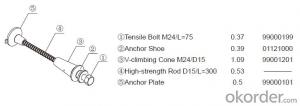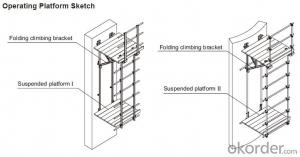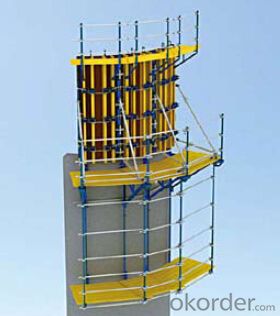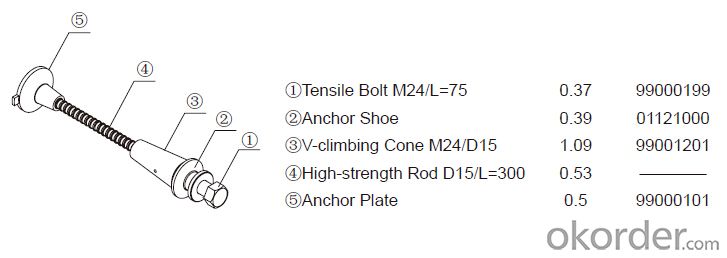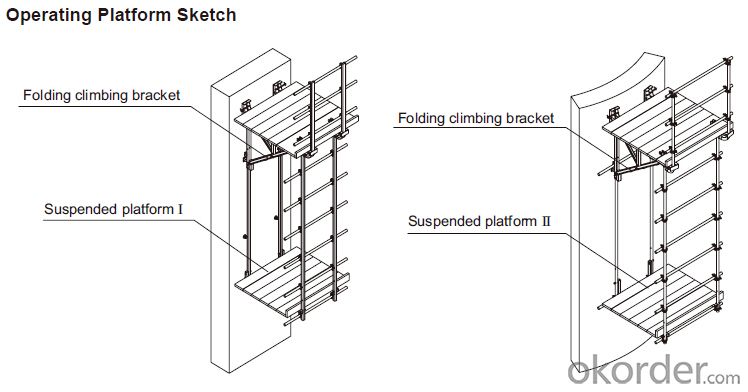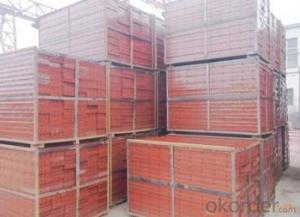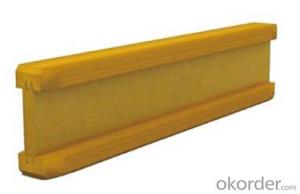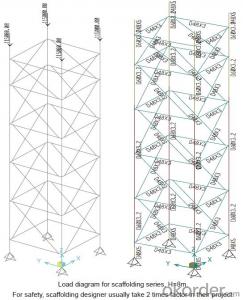Climbing Platform CP 190 for Formwork and Scaffolding systems
- Loading Port:
- Tianjin
- Payment Terms:
- TT OR LC
- Min Order Qty:
- 50 m²
- Supply Capability:
- 1000 m²/month
OKorder Service Pledge
OKorder Financial Service
You Might Also Like
Climbing Platform CP190
Climbing bracket CP190 is mainly used as operating platform during construction. It can be used
on the vertical wall and arced wall. The bracket hang on the anchor system and all the load are
supported by anchor system. It’s convenient to assemble and dismantle, the construction is easy,
rapid and safe.
Anchor System:
Anchor system is the most important supporting part. The system is made of five parts shown
below. There into, tensile bolt, anchor shoe and V-climbing cone can be taken out for reusing.
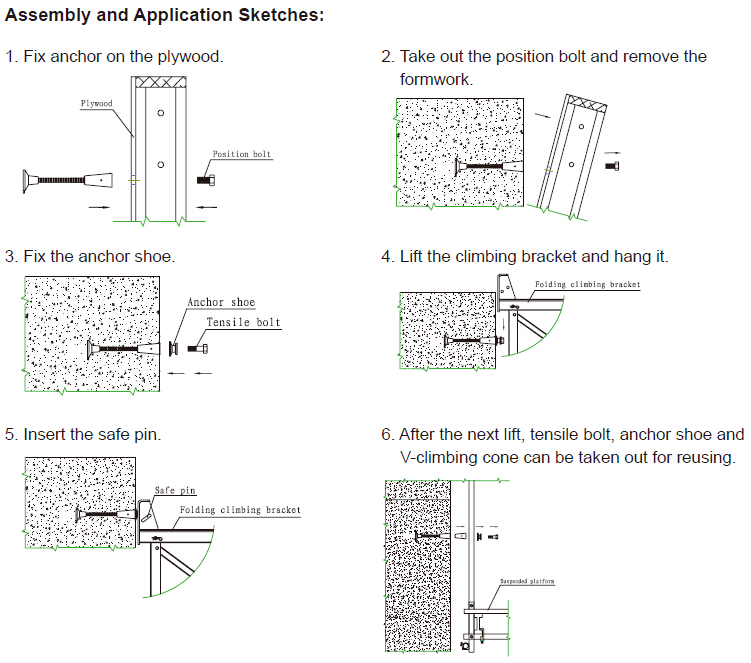
- Q: How does steel formwork handle concrete pouring and consolidation?
- Steel formwork is a highly durable and rigid material that is capable of handling the pressure and weight of concrete during pouring and consolidation. Its strong structure ensures that the formwork remains stable and does not deform under the weight of the concrete. The smooth surface of steel formwork also allows for easy and efficient pouring and spreading of concrete, ensuring a consistent and even distribution. Additionally, steel formwork's ability to withstand the pressure exerted during consolidation prevents any deformation or movement, resulting in a solid and well-structured concrete structure.
- Q: How does steel formwork prevent concrete shrinkage and cracking?
- Steel formwork helps prevent concrete shrinkage and cracking by providing strong and rigid support during the curing process. When concrete is poured into the steel formwork, it takes the shape of the structure being built and hardens over time. The steel formwork acts as a mold, holding the concrete in place and preventing it from shrinking or cracking as it dries. One of the main causes of concrete shrinkage and cracking is the loss of moisture during the curing process. As the water in the concrete evaporates, it causes the material to shrink. This shrinkage can lead to cracks forming in the concrete if it is not properly supported. Steel formwork helps prevent this shrinkage by providing a tight and secure enclosure for the concrete. It ensures that the concrete retains its moisture and does not dry out too quickly. This slow and controlled drying process allows the concrete to cure evenly and reduces the likelihood of shrinkage and cracking. Additionally, steel formwork provides stability and support to the concrete, preventing it from moving or shifting as it hardens. This stability helps to distribute the forces and stresses evenly, reducing the risk of cracking or structural failure. Furthermore, the smooth and rigid surface of steel formwork helps to achieve a high-quality finish on the concrete. This prevents any irregularities or imperfections that may weaken the structure or make it more susceptible to cracking. In summary, steel formwork plays a crucial role in preventing concrete shrinkage and cracking by providing support, stability, and moisture retention during the curing process. Its strong and rigid structure ensures that the concrete remains intact and achieves a high-quality finish, reducing the risk of structural issues and enhancing the durability of the construction.
- Q: How long does steel formwork last?
- The lifespan of steel formwork can vary depending on various factors such as the quality of the steel used, the type and frequency of usage, and the maintenance practices employed. Generally, steel formwork is known for its durability and longevity, and when properly maintained, it can last for several years or even decades. With regular maintenance and proper handling, steel formwork can withstand multiple uses and continue to perform effectively. However, it is important to note that steel formwork may experience wear and tear over time due to the constant exposure to concrete, which can lead to surface corrosion or deterioration. This can be mitigated by applying protective coatings or cleaning the formwork after each use. Furthermore, the lifespan of steel formwork can also be influenced by external factors such as environmental conditions and the type of concrete being poured. Harsh weather conditions or exposure to chemicals can accelerate the corrosion process, potentially reducing the lifespan of the formwork. To ensure the longevity of steel formwork, it is important to invest in high-quality steel with proper anti-corrosion properties, carry out regular inspections, and perform necessary maintenance and repairs when needed. By following these practices, steel formwork can last for a considerable amount of time, making it a cost-effective and reliable option for construction projects.
- Q: How does steel formwork help in achieving a high-quality finish?
- Steel formwork helps in achieving a high-quality finish due to its ability to provide a strong and rigid structure for concrete placement. Its smooth and non-absorbent surface prevents the formation of air bubbles, resulting in a smooth and even finish. Additionally, steel formwork allows for precise and accurate shaping and alignment, ensuring the desired dimensions and contours of the final concrete product.
- Q: What are the different safety certifications and standards for steel formwork?
- There are several safety certifications and standards for steel formwork used in construction projects. Some of the most common ones include ISO 9001 certification, which ensures quality management systems are in place; OHSAS 18001 certification, which indicates compliance with occupational health and safety standards; and EN 12812 standard, which defines requirements for temporary works equipment such as formwork. Additionally, local building codes and regulations play a crucial role in ensuring the safety of steel formwork installations.
- Q: What are the different types of lifting systems used with steel formwork?
- There are several types of lifting systems commonly used with steel formwork in construction projects. These lifting systems are designed to facilitate the transportation and installation of steel formwork panels, which are used to create the molds for concrete structures. Here are some of the different types of lifting systems used with steel formwork: 1. Crane lifting system: This is one of the most common and widely used lifting systems. It involves using cranes with hooks or specialized lifting attachments to lift and move the steel formwork panels to their desired location. Cranes provide the necessary strength and stability to handle heavy loads and are often used in large-scale construction projects. 2. Forklift lifting system: Forklifts are another popular option for lifting and moving steel formwork panels. These vehicles are equipped with forks that can slide under the formwork and lift it off the ground. Forklifts are particularly useful in smaller construction sites or areas with limited space, where cranes may not be feasible. 3. Hydraulic lifting system: Hydraulic systems utilize hydraulic power to lift and move the steel formwork panels. These systems are often integrated into the formwork itself, allowing for controlled lifting and lowering of the panels. Hydraulic lifting systems are known for their precision and ease of use. 4. Manual lifting system: In some cases, manual labor is used to lift and move steel formwork panels. This method typically involves a team of workers using ropes, chains, or other lifting tools to manually hoist the formwork into position. Manual lifting systems are usually employed for smaller formwork panels or in situations where other lifting systems are not available. 5. Self-climbing lifting system: Self-climbing systems are commonly used in high-rise construction projects. These systems are designed to lift and move the steel formwork vertically as the construction progresses. They often utilize hydraulic or mechanical mechanisms to lift the formwork to the next level, allowing for efficient and continuous construction. 6. Tower crane lifting system: Tower cranes are tall, freestanding cranes that are commonly used in large construction projects. They can lift and move steel formwork panels to various heights and locations on the construction site. Tower cranes offer excellent reach and versatility, making them suitable for projects with complex formwork requirements. Overall, the choice of lifting system for steel formwork depends on factors such as the size and weight of the formwork panels, the construction site's characteristics, and the specific requirements of the project. It is important to select the appropriate lifting system to ensure the safe and efficient installation of steel formwork.
- Q: How does steel formwork compare to aluminum formwork in terms of cost?
- In terms of cost, steel formwork generally tends to be more expensive compared to aluminum formwork. Steel is a stronger and more durable material, which results in higher production and material costs. Additionally, steel formwork requires more labor for handling and installation due to its heavier weight. On the other hand, aluminum formwork is lighter and easier to handle, reducing labor costs and increasing efficiency during construction. Moreover, aluminum formwork can be reused multiple times, resulting in considerable cost savings over multiple projects. Overall, while steel formwork offers superior strength and durability, it comes at a higher initial cost compared to aluminum formwork due to material and labor considerations.
- Q: How does steel formwork affect the overall fire resistance of the structure?
- Steel formwork does not directly affect the overall fire resistance of the structure as it is typically temporary and removed after the concrete is set. However, steel formwork can indirectly contribute to the fire resistance by ensuring the concrete is properly poured and cured, which can enhance the overall fire resistance of the structure.
- Q: How does steel formwork contribute to the overall durability of a structure?
- Steel formwork contributes to the overall durability of a structure in several ways. Firstly, steel formwork is highly resistant to wear and tear, which ensures that it can withstand the heavy loads and pressures exerted during the construction process. This durability prevents any deformations or damages to the formwork, ensuring that the structure is constructed accurately and without any compromise in its integrity. Additionally, steel formwork provides excellent dimensional stability, meaning that it retains its shape and size even under extreme conditions such as high temperatures or moisture exposure. This stability ensures that the concrete poured into the formwork maintains its desired shape and structural strength, resulting in a more durable and long-lasting structure. Furthermore, steel formwork offers superior strength and rigidity compared to other types of formwork materials. This strength enables it to support heavy concrete loads without any deformation or collapse, ensuring that the structure remains stable and secure. This characteristic is particularly important in the construction of large-scale structures such as bridges, high-rise buildings, or dams, where the formwork needs to bear significant loads for prolonged periods. Moreover, steel formwork is highly resistant to corrosion, which is a common cause of deterioration in construction materials. This resistance ensures that the formwork remains intact and unaffected by environmental factors such as moisture, chemicals, or exposure to the elements. As a result, the structure's overall durability is enhanced as the risk of corrosion-related damages is minimized. Lastly, steel formwork is reusable, which not only contributes to the sustainability of the construction process but also ensures cost-effectiveness. The ability to reuse the formwork multiple times reduces the need for additional materials and resources, resulting in less waste generation and lower construction costs. This factor also ensures that the formwork remains in good condition, as it can be properly maintained and inspected before each reuse, further enhancing its durability and longevity. In conclusion, steel formwork plays a crucial role in enhancing the overall durability of a structure. Its resistance to wear and tear, dimensional stability, strength, corrosion resistance, and reusability contribute to the construction of a robust and long-lasting structure, ensuring its integrity and minimizing the risk of structural failures or damages over time.
- Q: How does steel formwork prevent concrete spillage?
- To prevent concrete spillage, steel formwork is utilized as it provides a sturdy and inflexible framework. This framework effectively contains and secures the concrete in position throughout the pouring and curing stages. To ensure that the concrete does not escape, the steel formwork is meticulously designed with seamless joints and a smooth surface, leaving no room for gaps or leaks. Consequently, any potential spillage or leakage during the pouring process is avoided. Furthermore, the strength and stability of steel formwork are often enhanced by incorporating internal bracing or supports. This reinforcement fortifies the formwork, preventing any movement or distortion, and ensuring it maintains its intended shape and position. Consequently, the steel structure acts as a barrier, preventing the concrete from spilling or overflowing. In addition, steel formwork is typically constructed with securely connected vertical sides and bottom plates. This specific configuration establishes an effective containment system that securely holds the concrete in place, preventing it from flowing out or penetrating any crevices. The snug fit of the formwork also aids in achieving the desired shape and dimensions of the cast concrete structure. In conclusion, steel formwork is a dependable and sturdy solution to prevent concrete spillage. Its strength, rigidity, and seamless joints guarantee that the concrete is contained within the desired area, significantly minimizing the risk of spillage or leakage during the construction process.
Send your message to us
Climbing Platform CP 190 for Formwork and Scaffolding systems
- Loading Port:
- Tianjin
- Payment Terms:
- TT OR LC
- Min Order Qty:
- 50 m²
- Supply Capability:
- 1000 m²/month
OKorder Service Pledge
OKorder Financial Service
Similar products
Hot products
Hot Searches
Related keywords

